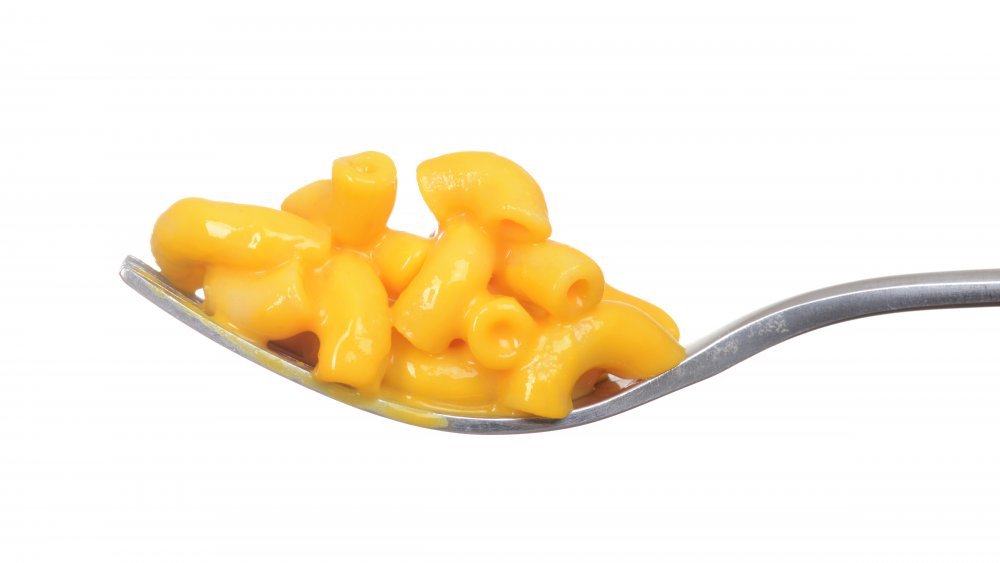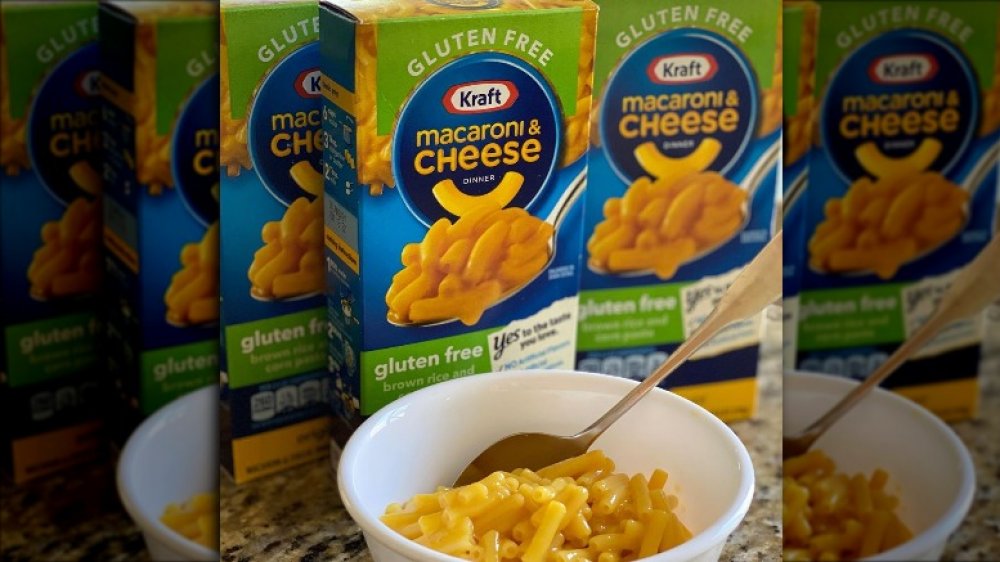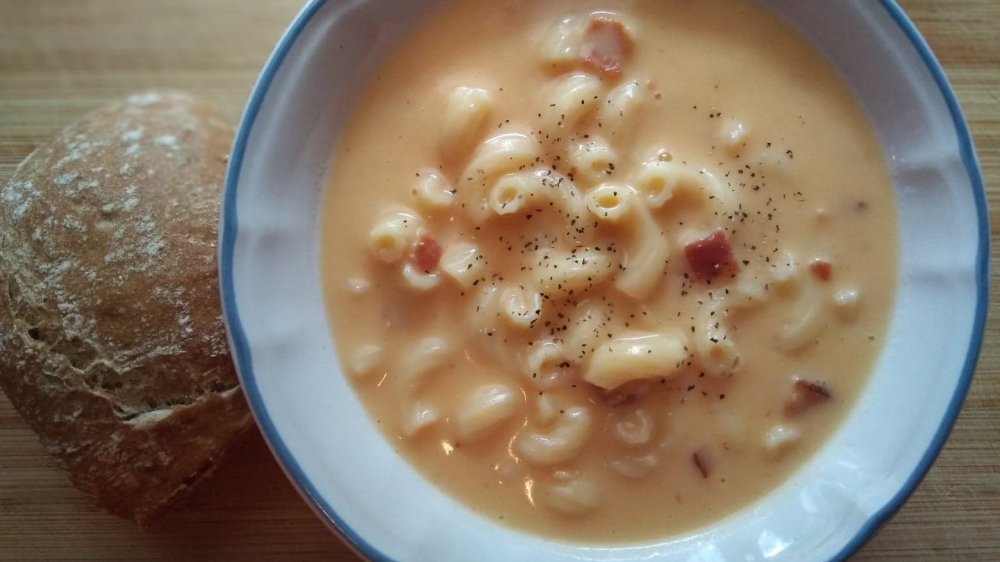The Biggest Mistakes You're Making With Mac And Cheese
Creamy yet crunchy. Smooth yet chewy. Utterly cheesy. Mac and cheese is the one of the simplest — and most satisfying — comfort foods of all time. For anyone who grew up making macaroni and cheese out of a box (which is practically everybody), there comes a time when you might feel ready to take a big leap forward: making macaroni and cheese from scratch.
"I've got this," you think to yourself. "Pasta, cheese, milk. Three ingredients. How difficult can it be?"
Warning! It's precisely this overconfidence in one's mac-and-cheese making abilities — combined with an underestimation of mac and cheese itself — that leads to so many disastrous outcomes. It's stunning the ease with which you can produce a flabby, mushy, bland, and grainy mess, simply by failing to use the right ingredients, ignoring techniques, and overlooking essential details. To save you from such humiliation — and a potential mac-and-cheese meltdown — we've compiled a list of expert advice to follow and fatal mistakes to avoid.
Making mac and cheese out of a box
First and foremost, let's get the big macaroni elephant out of the room. At the risk of coming off as an elitist or purist, we need to state that the most egregious mac and cheese mistake you can make is to rely on industrialized, boxed (or packaged) mac and cheese.
Yes, it's a convenient shortcut that avoids the complications of a roux and cuts down on dishwashing. Yes, it's cheaper than investing in quality pasta and bonafide cheeses, the kind that don't come in powder form or some glorious, otherworldly, radioactive shade of orange. And yes, you may argue that there are more artisanal, environmentally friendly and supposedly gourmet versions out there than the classic Kraft version — not to mention versions that are less caloric, more nutritious, and decidedly gluten-free. And you won't be alone. Social and digital media arbiters are only too eager to sing the praises of the best boxed brands on the market and suggest ingenious, easy ways to "upgrade" boxed mac and cheese.
But don't fall for these tactics. If you do, you'll be committing the original mac and cheese sin. Instead, stay on the true path by investing in honest ingredients and cooking from scratch. It's the only way you'll ever get to mac and cheese heaven.
Making terrible cheese choices for your mac and cheese
Mac and cheese is a marriage between two much-loved ingredients: pasta and cheese. For the union to succeed, both partners have to be simpatico. This can only happen if you choose the right cheese.
Right away, you can eliminate Velveeta. Although a fervent minority is partial to its undeniable creaminess, in the words of the FDA, it isn't a cheese, but a "cheese product." That said, dissing "Liquid Gold" doesn't mean you should run out and invest in an exorbitantly priced Wyke Farms Cheddar. In a HuffPost article, cheese guru Janet Fletcher warned against using insanely expensive, refined, or unusual cheeses, the qualities of which will be lost when you melt them.
Instead of limiting yourself to a single cheese, opt for a carefully selected blend of cheeses that you can layer. Chef Danyelle Hudgins points out that successful mac and cheese "needs loads of flavor and depth. Using different cheeses allows you to taste layers of flavor combos."
Kitchn food editor Kelli Foster explains that some cheeses melt more easily and have a creamier texture and milder flavor. Popular choices in this camp included fontina, gouda, gruyère, and Monterey jack. Others are sharper and more pungent such as cheddar, Parmesan, and even Roquefort. The trick is to find a balanced mix of simple but good-quality cheeses. Author of American Cheeses identifies three schools of thought on mac and cheese — in all schools, the common denominator is cheddar.
Skimping on the cheese in your mac and cheese
Assembling a stellar team of cheeses is key to earning accolades for your mac and cheese, but just as important as the type of cheeses you choose are the quantity and quality you use.
In terms of quantity, you need to be generous. By its very nature, mac and cheese is a cheese-heavy dish. If you want your mac to be lavishly coated in a thick, creamy blanket of cheese, you'll have to go heavy on the grater. Always grate more cheese than you think you're going to need (save any leftovers for other treats). Decadent? Yes. Then again, you're not going to be eating this every day (that's what Kraft mac and cheese is for). In the words of Kitchn editor Kelli Foster, "There's a time and place to go light on the cheese, but this is certainly not that time."
Moreover, make sure you actually do grate your own cheese. Sure, buying pre-shredded cheese is more convenient than doing it yourself. However, as Bon Appétit explains, any gains in efficiency will be offset by a loss in taste, texture, and quality. The truth is that pre-shredded cheese is frequently spiked with stabilizers and preservatives. While these ensure longer shelf life, the downsides include artificial flavors and frequently waxy textures combined with less melt-ability.
Using the wrong kind of mac for your mac and cheese
Having sorted out the cheese, there's still the mac side of the equation to be settled. One of the earliest forms of pasta known to humankind, macaroni is a narrow tube-shaped noodle. In America, it's become indissociable from what is actually a subset of macaroni, elbow macaroni, the name of which comes from its resemblance to a bent elbow.
In "Macaroni cheese's mysterious origins," pasta sleuth Adam H. Graham traces mac and cheese's probable beginnings to the Swiss Alps where shepherds often combined home-made cheeses with pasta. Known as hörni, these ancestors of elbow macaroni were shaped like the horns of Alpine ibex.
Mac and cheese allegedly arrived in America courtesy of Thomas Jefferson, who returned from a European jaunt laden down with pasta recipes — and a pasta-making machine. In 1802, he was said to have served mac and cheese at a state dinner. However, it was Kraft that truly popularized the dish made with elbow macaroni when it launched its boxed version in 1937.
Since then, elbow macaroni has remained the standard. More than a matter of tradition or aesthetics, it's a question of engineering. Cheese sauce is too heavy for many pastas, causing them to clump. Elbow macaroni is designed to hold thick, creamy sauces. Its curves and grooves catch and hold onto sauce, maximizing cheesiness with every bite. For similarly strategic reasons, alternatives include other small and groovy pasta shapes such as conchiglie (shells) and campanelle (bells).
Making mac and cheese mush
Choosing the right mac is essential, but it's all for naught if you don't cook it properly. First things first, make sure you only use (a decent brand) of dry pasta as opposed to fresh pasta, which, as explained in "The Science of Dried Pasta," will turn into a sticky clump.
Smithsonian Magazine's "Guide to Making Perfect Pasta" recommends bringing your water to a rolling boil and then tossing in at least one heaping tablespoon of (preferably kosher) salt, a step that will ensure your mac possesses some fundamental seasoning from the start (chef Mario Batali decrees that the water should taste like the sea). Do not, as Lidia Bastianich has famously declared, add oil to the water, since doing so can prevent the cheese sauce from sticking to the pasta.
Because many recipes for macaroni are double-cooked — boiled and then baked — you'll want to drain your pasta when it's just a minute or two shy of al dente. Anything more will result in flabby noodles lacking in chewiness and unable to absorb the sauce, i.e. a mushy mess.
Finally, when you do drain your cooked pasta, don't rinse it. This will wash away all the noodles' coveted starch, which helps bind the cheese sauce to the macaroni.
Sabotaging your béchamel for your mac and cheese
One of the trickiest parts of the mac and cheese-making process is making the béchamel sauce. Considered one of the five classic mother sauces of French cooking, this thick white sauce was named after Louis de Béchamel, a steward of French king Louis XIV, who was also a noted gourmet. However, the sauce's origins can be traced to Tuscany, where it was evocatively known as salsa colla, or "glue sauce."
Béchamel sauce relies on a simple trio of ingredients: milk, butter, and flour. The combination of butter and flour cooked slowly over low heat is known as a roux. Despite the simplicity of the ingredients involved, béchamels are disaster-prone. For instance, the roux has a nasty habit of sticking to the bottom of the pan and burning while the béchamel is simmering. Chef's Notes recommends using a pot with a heavy bottom and stirring as if your life depends upon it (your mac and cheese certainly does).
Ina Garten's technique of warming the milk before adding it to the roux not only thickens the sauce in half the time but also reduces splattering that inevitably occurs when cold milk meets hot butter. Make sure you add the milk slowly, little by little. If you undercook your béchamel (ten minutes is a safe minimum), you risk giving it a gritty texture and raw-flour taste.
Using the wrong kind of milk for your mac and cheese
When it comes to milk, percentages are everything. As Chef's Notes observes, when making mac and cheese, many of us idealistically, and erroneously, assume that all milk is created equal. However, using anything with less fat than whole milk — with a 3.25 percent fat content — is courting catastrophe.
The higher a milk's fat content, the more stable it will be during cooking. If you opt for reduced-fat (two percent), low-fat (one percent), or skim (zero percent) milk to make your béchamel sauce, there's a higher percentage chance of your mac and cheese acquiring an unpleasantly greasy texture and look.
If you don't have any whole milk on hand, Chef's Notes recommends substituting cream (whipping or heavy) at a ratio of one part cream to three parts two-percent milk. Then again, if you're investing in cream, you may want to go all out in terms of fat content and use either light cream (20 percent fat), whipping cream (35 percent fat) or heavy cream (38 percent fat) to make what Epicurious describes as the "creamiest, dreamiest" mac and cheese sauce you can imagine.
Making a soup instead of a sauce for your mac and cheese
Almost as culinarily catastrophic as mushy mac and cheese is a soupy sauce. This major mishap can occur if you add too much liquid to what should ideally be a rich, thick, creamy cheese sauce.
Steer clear of disaster by adding liquids a little bit at a time, stirring them into the sauce until well-blended, and then taking stock of your sauce. If you find it to be a little on the sludgy side, you can always add a little more liquid, but subtracting is more difficult.
Similarly, never add your grated cheese all at once to your béchamel sauce. Whisk in each variety of cheese, little by little, stirring until the sauce is perfectly blended. Chef's Notes warns that if you add too much cheese, too quickly, your sauce can split or become unstable while cooking. This slow, steady method of blending also prevents cheese's natural oils from separating out from the sauce during cooking, creating unappetizing pools of grease.
Skimping on seasoning in your mac and cheese
You might think that a brilliant selection of zesty cheeses is all it takes to make a flavorful mac and cheese. In reality, however, the best versions of mac and cheese benefit significantly from a behind-the-scenes boost of spices that add subtle notes while pumping up the flavor.
While butter, flour, and milk make a great base for a sauce, the resulting flavor isn't going to tempt you to lick the mixing spoon. Adding a judicious sprinkling of spices will enhance the flavors both of your béchamel sauce and of the completed mac and cheese.
Aside from salt and ground black pepper, favorite options include dashes of nutmeg and cayenne pepper for warmth and spark. A sprinkling of mustard powder and/or a blob of Dijon mustard are also zingy antidotes to blandness, as are garlic powder and onion powder. A dusting of paprika or turmeric adds a tinge of pungency as well as a healthy golden tint to the final cheesy color scheme.
Failing to maximize the mac and cheese crunch ratio
Mac and cheese is more than just a marriage between pasta and cheese. It's also about the happy union of creaminess and crunchiness. Smooth macaroni in luscious cheese sauce truly comes into its own when paired with its culinary soul mate: a crackling browned topping.
Although creating a top crust of gratinéed cheese is one way of achieving such crunch, the consensus among mac and cheese experts is that you can't achieve maximum crunch without also using breadcrumbs for, what Bon Appétit's Rochelle Bilow describes as a "one-two punch."
On their own, hard, dry cheeses add sharp flavors but burn easily. Meanwhile, if left unaccompanied, soft, creamy cheeses will make a gooey mess without developing that desirable golden gratinéed look. Chef Vincent Menager recommends using a strategic mix of both types. Even though you're using cheese, make sure to season your breadcrumbs before tossing them into the mix. Melted butter, fresh parsley, crushed garlic, and onion powder are worthy additions that add welcome spice.
Guided by her belief that mac and cheese's crunch ratio should be an equitable 50:50 partnership, Food 52's Amanda Hesser ups the crunch factor further by spreading her mac and cheese on a baking sheet and blitzing it under the broiler at the end of its bake. An alternative suggested by Bon Appétit's test kitchen is to use a wide, shallow casserole pan, preferably glassware, so you can monitor the browning of both bottom and top layers.
Refusing to let your mac and cheese take a rest
It takes a very strong-willed individual to remove a fragrant, crackling, bubbling pan of mac and cheese from the oven and not succumb to its lure by immediately helping yourself to a big heaping bowl full of cheesy deliciousness.
However, despite appearances to the contrary, mac and cheese is not unlike a slab of beautifully grilled or roasted meat. The flavors and textures of both meat and mac hit their peak if they're allowed to rest for ten to fifteen minutes upon being taken out of the oven. According to culinary director Damon Menapace, taking a short siesta gives the cheese sauce an opportunity to calmly settle around the macaroni, burrowing into its nooks and crannies. If you don't let your mac enjoy this rest, the sauce will literally be a hot (and runny) mess.
It may be hard, but try to stop yourself from digging into that dish as soon as it comes out from the oven.
Taking yourself — and your mac and cheese — too seriously
Yes, mac and cheese has been scientifically deconstructed and reconstructed by The Food Lab. But as every self-respecting toddler knows, at its essential level, mac and cheese is simple, gooey, delicious fun. To be true to the spirit of this classic comfort food, it's essential to keep its preparation as uncomplicated as possible.
Aside from seeking out arcane and expensive cheeses, such as the outrageously priced Wyke Farms Cheddar, this means stomping on any inner urge to fuss things up with foodie-friendly suggestions such as truffle oil and the ubiquitous lobster.
As part of our endless search for variety, the online universe is full of advice on how to "jazz up," "dress up," "spice up," "kick up," "amp up," and "pimp up" mac and cheese by adding everything from chorizo and figs to leftover chili, not to mention guacamole and tortilla chips. Such hacks are not only misguided (and in a few cases mildly disgusting) but completely unnecessary. As Brad Leone, kitchen manager of Bon Appetit's test kitchen, puts it: "Don't put a ton of crap in it."
That said, we're not endorsing the other extreme, exemplified by the young Florida man featured in a Vice documentary, who ate nothing but pure and unadulterated mac and cheese for 17 years.
Not thinking outside the mac and cheese bowl
It may be considered culinary heresy to pollute a classic recipe with unnecessary bells and whistles. Yet once you've steered clear of all mistakes and followed all the steps required to make a perfect pan of mac and cheese, there's no rule that says you can only serve and consume it in a bowl.
As The Spruce Eats points out, since both mac and cheese and grilled cheese sandwiches rely on two basic ingredients — pasta and cheese and bread and cheese — it seems only natural to amalgamate these two cheesy and chewy classics into a grilled mac and cheese sandwich.
Perhaps less natural but equally inspired is the addition of mac and cheese to other iconic comfort foods. Layer a generous helping of mac and cheese onto a pizza crust, add some extra cheese, and blast it in the oven to enjoy a mac and cheese pizza. Press mac and cheese into a bun alongside a freshly grilled hot dog for a mac and cheese dog. Make a chewier variation of a cheeseburger by topping, or even filling, a juicy burger with mac and cheese. And if you're a real starch fiend, use mac and cheese to stuff baked potatoes. Ultimately, in terms of its appetizing possibilities, mac and cheese is endlessly adaptable — the only limit is your imagination.













